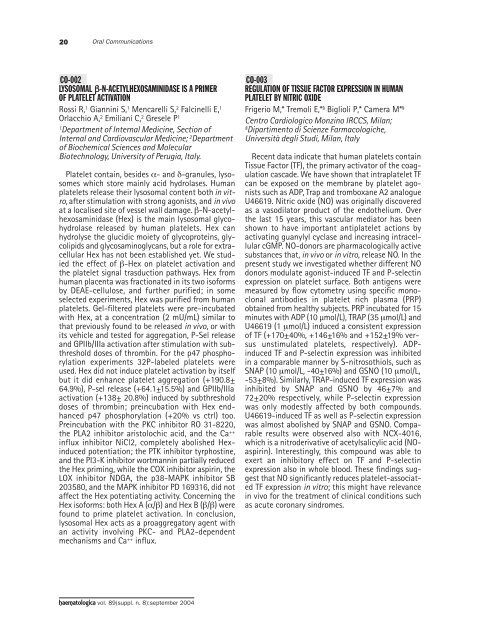Haematologica 2004;89: supplement no. 8 - Supplements ...
Haematologica 2004;89: supplement no. 8 - Supplements ...
Haematologica 2004;89: supplement no. 8 - Supplements ...
- No tags were found...
Create successful ePaper yourself
Turn your PDF publications into a flip-book with our unique Google optimized e-Paper software.
20Oral CommunicationsCO-002LYSOSOMAL β-N-ACETYLHEXOSAMINIDASE IS A PRIMEROF PLATELET ACTIVATIONRossi R, 1 Giannini S, 1 Mencarelli S, 2 Falcinelli E, 1Orlacchio A, 2 Emiliani C, 2 Gresele P 11Department of Internal Medicine, Section ofInternal and Cardiovascular Medicine; 2 Departmentof Biochemical Sciences and MolecularBiotech<strong>no</strong>logy, University of Perugia, Italy.Platelet contain, besides α- and δ-granules, lysosomeswhich store mainly acid hydrolases. Humanplatelets release their lysosomal content both in vitro,after stimulation with strong agonists, and in vivoat a localised site of vessel wall damage. β-N-acetylhexosaminidase(Hex) is the main lysosomal glycohydrolasereleased by human platelets. Hex canhydrolyse the glucidic moiety of glycoproteins, glycolipidsand glycosami<strong>no</strong>glycans, but a role for extracellularHex has <strong>no</strong>t been established yet. We studiedthe effect of β-Hex on platelet activation andthe platelet signal trasduction pathways. Hex fromhuman placenta was fractionated in its two isoformsby DEAE-cellulose, and further purified; in someselected experiments, Hex was purified from humanplatelets. Gel-filtered platelets were pre-incubatedwith Hex, at a concentration (2 mU/mL) similar tothat previously found to be released in vivo, or withits vehicle and tested for aggregation, P-Sel releaseand GPIIb/IIIa activation after stimulation with subthresholddoses of thrombin. For the p47 phosphorylationexperiments 32P-labeled platelets wereused. Hex did <strong>no</strong>t induce platelet activation by itselfbut it did enhance platelet aggregation (+190.8±64.9%), P-sel release (+64.1±15.5%) and GPIIb/IIIaactivation (+138± 20.8%) induced by subthresholddoses of thrombin; preincubation with Hex endhancedp47 phosphorylation (+20% vs ctrl) too.Preincubation with the PKC inhibitor RO 31-8220,the PLA2 inhibitor aristolochic acid, and the Ca ++influx inhibitor NiCl2, completely abolished Hexinducedpotentiation; the PTK inhibitor tyrphostine,and the PI3-K inhibitor wortmannin partially reducedthe Hex priming, while the COX inhibitor aspirin, theLOX inhibitor NDGA, the p38-MAPK inhibitor SB203580, and the MAPK inhibitor PD 169316, did <strong>no</strong>taffect the Hex potentiating activity. Concerning theHex isoforms: both Hex A (α/β) and Hex B (β/β) werefound to prime platelet activation. In conclusion,lysosomal Hex acts as a proaggregatory agent withan activity involving PKC- and PLA2-dependentmechanisms and Ca ++ influx.CO-003REGULATION OF TISSUE FACTOR EXPRESSION IN HUMANPLATELET BY NITRIC OXIDEFrigerio M,* Tremoli E,* § Biglioli P,* Camera M* §Centro Cardiologico Monzi<strong>no</strong> IRCCS, Milan;§Dipartimento di Scienze Farmacologiche,Università degli Studi, Milan, ItalyRecent data indicate that human platelets containTissue Factor (TF), the primary activator of the coagulationcascade. We have shown that intraplatelet TFcan be exposed on the membrane by platelet agonistssuch as ADP, Trap and tromboxane A2 analogueU46619. Nitric oxide (NO) was originally discoveredas a vasodilator product of the endothelium. Overthe last 15 years, this vascular mediator has beenshown to have important antiplatelet actions byactivating guanylyl cyclase and increasing intracellularcGMP. NO-do<strong>no</strong>rs are pharmacologically activesubstances that, in vivo or in vitro, release NO. In thepresent study we investigated whether different NOdo<strong>no</strong>rs modulate agonist-induced TF and P-selectinexpression on platelet surface. Both antigens weremeasured by flow cytometry using specific mo<strong>no</strong>clonalantibodies in platelet rich plasma (PRP)obtained from healthy subjects. PRP incubated for 15minutes with ADP (10 µmol/L), TRAP (35 µmol/L) andU46619 (1 µmol/L) induced a consistent expressio<strong>no</strong>f TF (+170±40%, +146±16% and +152±19% versusunstimulated platelets, respectively). ADPinducedTF and P-selectin expression was inhibitedin a comparable manner by S-nitrosothiols, such asSNAP (10 µmol/L, -40±16%) and GSNO (10 µmol/L,-53±8%). Similarly, TRAP-induced TF expression wasinhibited by SNAP and GSNO by 46±7% and72±20% respectively, while P-selectin expressionwas only modestly affected by both compounds.U46619-induced TF as well as P-selectin expressionwas almost abolished by SNAP and GSNO. Comparableresults were observed also with NCX-4016,which is a nitroderivative of acetylsalicylic acid (NOaspirin).Interestingly, this compound was able toexert an inhibitory effect on TF and P-selectinexpression also in whole blood. These findings suggestthat NO significantly reduces platelet-associatedTF expression in vitro; this might have relevancein vivo for the treatment of clinical conditions suchas acute coronary sindromes.haematologica vol. <strong>89</strong>(suppl. n. 8):september <strong>2004</strong>
















